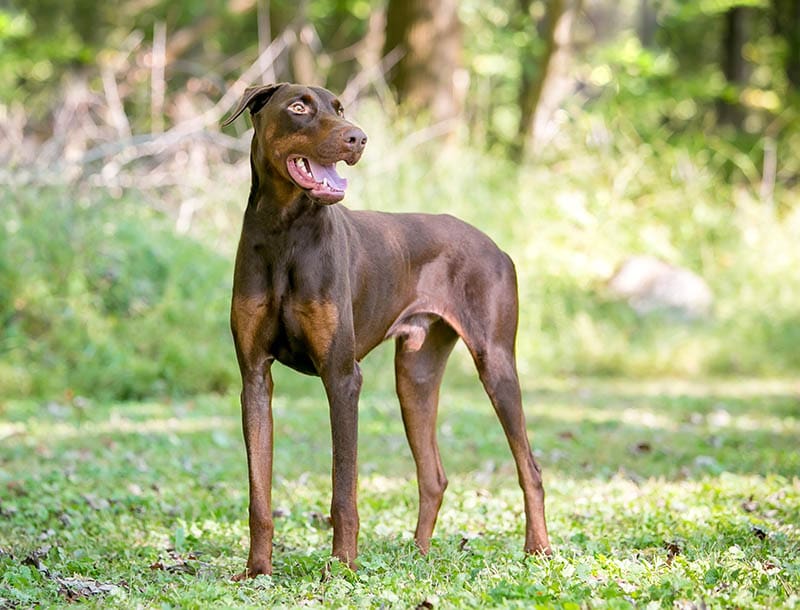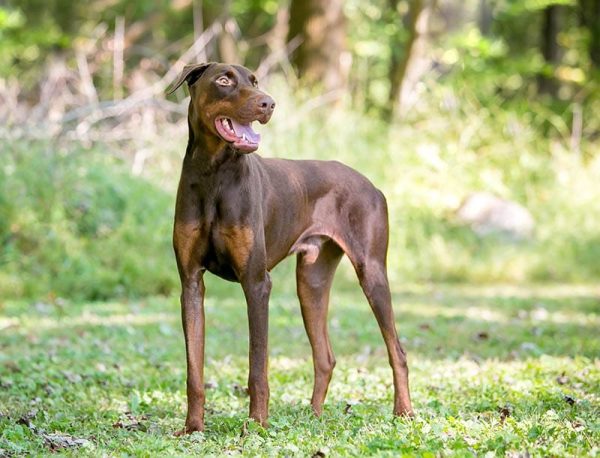Click to Skip Ahead
Breed Overview
Height:
24 – 28 inches
Weight:
60 – 80 pounds
Lifespan:
10 – 12 years
Colors:
Black, Blue, Brown, Fawn, Red
Suitable for:
Active families, Those with larger living areas
Temperature:
Loyal & Loving, Easy to train, Territorial
With their long legs and muscular physique, Dobermans are one of the most visually striking dog breeds you’ll ever see. Red Dobermans may not be as common as the black version of these pups, but they certainly make an impression. In this article, we’ll cover the history and origin of the red Doberman. You’ll also learn some interesting facts about this breed and details of what it’s like to have one as a pet.
Doberman Pinscher Characteristics
The Earliest Records of Red Doberman in History
The first Dobermans were bred in Germany in the latter half of the 19th century. A tax collector named Louis Dobermann, who was also interested in dog breeding, was responsible for the breed’s development. He wanted to create an intimidating guard dog who could travel with him for protection.
Mr. Dobermann combined breeds like the Rottweiler, German Pinscher, Black-and-tan terrier, Weimaraner, and others to breed the earliest Dobermans. The first Dobermans were probably the more widely known black-coated variety, and we don’t know precisely when the first red Dobermans were born. However, as one of four officially recognized coat colors, red Dobermans have most likely existed since the beginning of the breed’s creation.

How Red Doberman Gained Popularity
Red Dobermans quickly gained popularity as versatile working dogs. After Dobermann’s death, another German businessman founded the first Doberman club and established a breed standard. His Doberman breeding kennel exported many dogs out of Germany and helped spread the breed’s popularity around the world.
In America, the Dobermans’ popularity grew slowly but steadily through the early part of the 20th century. They were primarily used as working dogs by the police and military, which limited their numbers. However, after World War II, where Dobermans served bravely with U.S. Marines, their popularity surged, and they remain in the country’s top 20 most registered breeds.
Formal Recognition of Red Doberman
Red Dobermans first appeared in dog shows soon after their development, in the late 19th century. They were first formally recognized as a separate breed in 1900. The American Kennel Club (AKC) registered its first Dobermans in 1908. The first Doberman won best in show at the Westminster Kennel Club in 1939, soon before the breed became well-known for their military heroism.
The first Doberman Club in America was founded in 1921 and was dedicated to continuing the quality of the breed. In 1952 and 1953, Dobermans were back-to-back Westminster winners, further increasing the breed’s popularity. Currently, the Doberman ranks 16th in popularity out of 284 species formally recognized by the AKC.

Top 4 Unique Facts About Red Doberman
1. Red Dobermans Are One of Four Official Coat Colors
According to the AKC breed standard, red (technically red and rust) is one of the four Doberman coat colors permitted in the show ring. The others are black, blue, and fawn, all with rust-colored markings on their legs, belly, and face. Black-and-rust Dobermans are the most common and popular, but red Dobermans generally come in second.
2. Red Dobermans Are War Heroes
We’ve mentioned their war service already, but Dobermans of all colors are associated with the U.S. Marine Corp. During the Battle of Guam, one of the most well-known conflicts of World War II, Doberman war dogs suffered heavy losses alongside their human service members. Twenty-five Dobermans were killed during this battle. A statue of a Doberman is featured at the War Dog Cemetery in Guam.

3. Red Dobermans Can Do It All
As you might expect from a dog bred to work, red Dobermans are athletic and energetic dogs. We’ve already mentioned some of the jobs this breed has held, but you’ll also find them performing search and rescue work and as guide dogs. They also excel in canine sports such as agility, protection, obedience, tracking, and flyball.
4. Red Dobermans Have Some Health Issues
Red Dobermans, like all members of the breed, are impacted by some breed-specific inherited health issues. They are prone to a heart condition called Dilated Cardiomyopathy and a blood disorder called von Willebrand’s Disease. Wobbler’s syndrome, a spinal condition, is also common among Dobermans.
Does Red Doberman Make a Good Pet?
Despite their history as a guard and protection animal, red Dobermans also make excellent pets, although they are best suited to more experienced dog owners.
Dobermans tend to be naturally suspicious of strangers, and their owners must commit to diligent socialization and training from a young age to help them learn to be good citizens. A well-socialized Doberman should be gentle and affectionate with their family. They don’t always get along with other pets, but socialization and gradual introductions can help familiarize the dog with other animals.
Red Dobermans are intelligent and energetic dogs that need plenty of daily exercise, and they make good running and hiking partners.
Positive and consistent training methods are most effective for this breed. They can be stubborn and sometimes trend toward being dominant. Inexperienced dog owners shouldn’t be afraid to seek professional assistance to ensure their Doberman is a calm, well-trained pet.

Conclusion
If you’re intrigued by what you just read and consider welcoming a red Doberman into your family, choose your breeder carefully. With several inherited health conditions common in Dobermans, look for a breeder who performs all recommended health screenings and is transparent about the medical history of their dogs.
Despite these health issues, Dobermans tend to have longer lifespans for a large breed. Make sure you’re prepared to commit the time and money necessary to ensure your red Doberman enjoys a long, happy, and healthy life with your family.
Featured Image Credit: Mary Swift, Shutterstock









